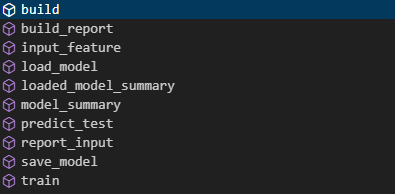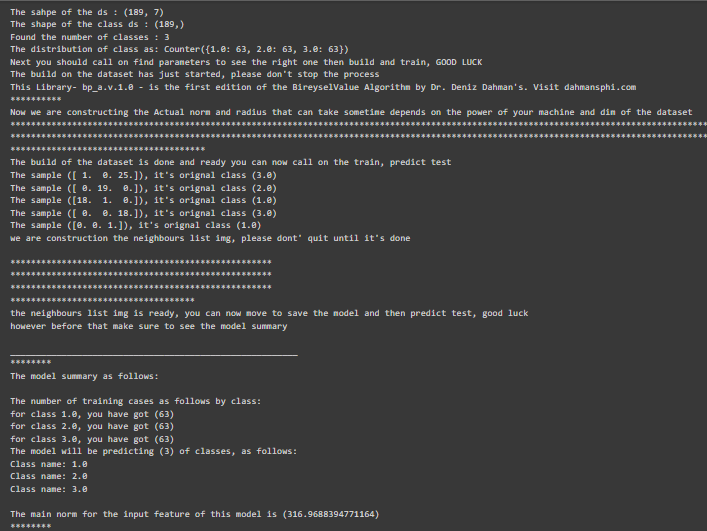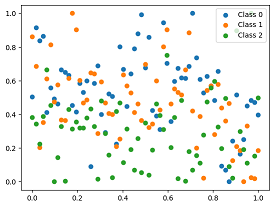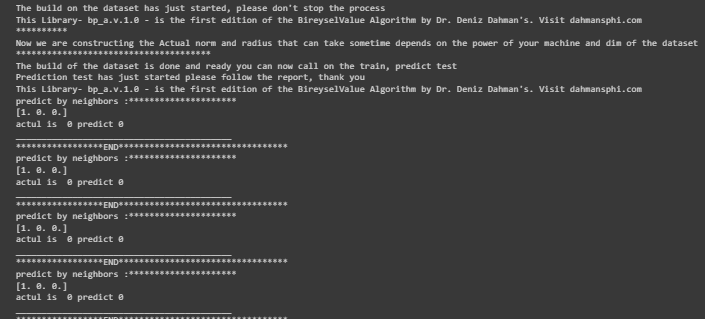Welcome to the first Edition of the Bireyselvalue Algorithm official documentation. I am Dr. Deniz Dahman the creator of the BireyselValue algorithm and the author of this package. In the following section you will have a brief introduction on the principal idea of the BireyselValue algorithm. In addition, a reference to the academic publication on the method. Before going ahead, I would like to let you know that I have done this work as an independent scientist without any fund or similar capacity. I am dedicated to proceeding and seek further improvement on the proposed method at all costs. To this end if you wish to contribute in any way to this work, please find further details in the contributing section.
If you wish to contribute to the creator of this method and the author, you may want to check possible ways on:
To Contribute in any way possible, thank you, you can check:
- view options to subscribe on Dahman's Phi Services Website
- subscribe to this channel Dahman's Phi Services
- you can support on patreon
If you prefer any other way of contribution, please feel free to contact me directly on contact.
Thank you
Classification is something that exists in nature in a very mysterious way. In fact, I do believe that
our evolution in some way is related to the principle of classification. See, we like to classify things,
sometimes, we use a set of adjectives e.g. the good one, the bad one, the far one the close one, etc.
Other times, we intend to use a set of nouns, i.e. classifying by group names, e.g. the A group,
the South way, etc. That’s weird itself, as I am trying to introduce the definition of classification,
I did classify two ways already, as if an infinite circle. Anyway, see here are two ways we classify things,
one I called the subjective way of classification using adjectives, the second is objective way of classification using nouns. These are how society tends to use the principle of classifications using the human language.
That has been said, there is this magical tool that uses its own independent language, tends to dissolve this
line of difference between subjectivism, and objectivism, and that is the use of mathematics.
In mathematics, we tend to convert everything into set of numbers, yet to understand the behavior and the structure
of those numbers, and finally, we just see how things are grouped.
To this end, I introduce a new method of classification that is BireyselValue Algorithm. Bireysel in Turkish language it means (individual, personal). The method is structured based on three blocks,
- the building block,
- the training block,
- and the prediction block.
It basically, relays on 4 characteristics, I call them the personal profile. To learn the details of this method please check out the official academic publication found in the reference.
As scientists we must be skeptical. Not in a destructive way but in a constructive way, so to speak. So, the best approach to be a constructive scientist is to build your research first in an abstract way then in a concrete way. To this end, I have proposed the method and its structure, yet, I had to introduce a concrete measure on that proposal, and that is the purpose of this package. This package is the first edition of the BireyselValue Algorithm, official released name bireyselvalue. This package will serve as a testing tool on the proposed method, of its first edition. In other words, not yet for a production capacity, but rather for research and development purposes ONLY. The essential finding on accuracy of prediction is very much promising. In future releases, enhancement of extra features will be added, and yet to be tested. To this end, you may feel free to follow the set-up instructions as the following sections suggest.
Tip
The first edition bireyselvalue is tested on several problematic datasets. What I mean by problematic is a dataset with extreme overlapping behaviors across classes and has insufficient classification accuracy using other classification methods. Those sets have various dimensions that go as high as 13000 observations and 36 variables. I employed the method using a very basic machine capacity that today’s industry can offer. To conclude, you don’t need any advanced hardware capacity but only basic ones. In addition, you make sure you have Python 3 or above version.
to install the package all what you have to do:
pip install bireyselvalue
You should then be able to use the package. You may want to confirm the installation
pip show bireyselvalue
The result then shall be as:
Name: bireyselvalue
Version: 1.0.0
Summary: TEST ON V.1 of THE BireyselValue Algorithm FOR CLASSIFICATION PROBLEMS
Home-page: https://github.com/dahmansphi/bireyselvalue_v1
Author: Dr. Deniz Dahman's
Author-email: dahmansphi@gmail.com
Important
It’s mandatory, to use the first edition of bireyselvalue, to make sure the training dataset meets the conditions:
- Number of observations > 40 per class
- Number of variables >= 2
- Number of classes >= 2.
Once these conditions are met then you may employ the bireyselvalue. Anyway, the package has a condition built in to make sure those conditions are met.
As I have mentioned in the introduction, there are three blocks for the bireyselvalue to make the final prediction. Essentially, we need a training dataset that the package will build, then train. Eventually, we call on the predict_test to test the result. Since this is the first edition as a testing block for the method, you will see that the only active function for prediction is predict_test. To this end you need to make sure:
- The training dataset is separated from the class vector. i.e. you should have the ds and the cls. Where the shape of ds should be m x n and the cls should be m x 1
- The test dataset is separated from the class vector. i.e. you should have the ds_test and the cls_test. Where the shape of ds_test should be m x n and the cls_test should be m x 1.
- both training and testing dataset shall be of numpy type dataset.
Once your installation is done, and you have met all the conditions, then you may want to check
the build-in functions of the bireyselvalue and understand each.
Essentially, if you create an instance from the bireyselvalue as so:
from bireyselvalue.bireyselvalue import BireyselValue
inst = BireyselValue()
now this inst instance offers you access to those build in functions that you need. this is a screenshot:
Once you have bireyselvalue instance, here are the details of the right sequence to employ the bireyselvalue:
the train block. you must and option:
- MUST call the
input_feature()which expect two args the ds and the cls vector class - OPTION you can call
report_input()which will give a comrehensive report on the ds and visual graph on the class overlapping status, see the screenshots below - MUST you call
build()this main function expects one argument that is the radius which must be within range 0.1 <= r <= 0.99. the function of the radius can be understood from the acadamic publication of the bireyselvalue algorithm refere to the reference - OPTION you may cal
build_report()this function expect arg as number that will display a sample of the neighbors list. once again you may want to the check the publication paper to understand the ns. - MUST you cal
train()this is the third main function that will do the train process - OPTION you may call
model_summary()this function will give you a detail summary on the model
once you have your model and all the report and summary details then you are ready. so you have to call then
the save_model() which expects of course the path to where to save
of course it's time now to load that saved model which hass the 5 parameters the bireyselvalue relays on.
we first of course create a new instance from the BireyselValue then call the load_model(). you have
an option to view the details on that loaded model as well calling the loaded_model_summary().
screenshots illustrate that.
finally what you aim for, the classification step calling predict_test() this function expect two args:
the test_ds, and the cls_test vector. the reason that is only predicting test is explaind below sections.
resul as the graph illustrates

If you like, I may suggest this way of employing the pacakge, for testing purpose. basically we can relay on creatin functions. follow the steps as:
- create a training function
- create a save model function
- create a load model function
- create a test model function
and finaly you may call main() function on each one. Otherwise you may also use Class, all as you wish.
Lest's see each function in action:
the training function expects four args:
- the training ds
- the training class vector
- the radius number
0.1 <= r <= 0.99 - number of report
neighbors, assume 5
Now, if elements 3, and 4 sound foreign to you, you should read the academic publication on
the method to understand their functions. Once that is done then you expect the function returns instance of the bireyselvalue that is build and trained. Technically speaking, that is the model to save.
def train_bp_a(ds, cls, radius, report_num):
'''this is the first main function on using this package, it expects
the ds, cls, and radius, and how many report you wish to see from the neighbors parameter.
it basically return the model for saving purpos
'''
inst = BireyselValue()
inst.input_feature(ds=ds, cls=cls)
inst.report_input()
inst.build(radius=radius)
inst.build_report(num=report_num)
inst.train()
inst.model_summary()
return inst
This function will save the returned model from the training section. It expects two args and that is the model and the path to save to.
def save_model(inst,path_save):
'''this function basically save the bp_a.v.1.0 model, requrist two args:
1. the model to save that should be bp_a model instance
2. the path of saving the model
'''
inst.save_model(file_name=path_save)
as the name suggests, we are going to load the model. the function expects ONE arg:
the path to load from, and it returns that model.
def load_model(path_load):
'''this function basically load the bp_a.v.1.0 model and return it, requires the path of the model to load'''
model_path = path_load
model = BireyselValue()
model.load_model(model_path=model_path)
model.loaded_model_summary()
return model
this is the final function to test the model. basically this function expects three args: the model which has been loaded, the test dataset, and finally the vector class. that is done then you feed all to the function, and you expect the result will be printed on the terminal.
def test_bp_a(model, ds_test, cls_test):
'''this function execute the test on bp_a. requires:
1. model
2. ds test
3. cls test
both must be following the loaded model summary
'''
model.predict_test(input_test_feature=ds_test, cls_test_feature=cls_test)
Finally, you expected a printed report with accuracy on the terminal as:
__________________________________________
*****************END*********************************
predict by neighbors :*********************
[0.30769231 0. 0.69230769]
actul is 2 predict 2
__________________________________________
*****************END*********************************
predict by neighbors :*********************
[0. 0. 1.]
actul is 2 predict 2
__________________________________________
*****************END*********************************
predict by neighbors :*********************
[0.63636364 0. 0.36363636]
actul is 2 predict 0
__________________________________________
*****************END*********************************
Your prediction test has accuracy of **94.73684210526315 %**, by neighbors:
you may follow this block to on the previous functions:
# train model
inst = train_bp_a(ds=ds, cls=cls, radius=0.2, report_num=5)
# save the model
save_model(path_save=path_to_save, inst=inst)
# load model
model = load_model(path_load=path_to_load)
# test model
test_bp_a(ds_test=ds_test, cls_test=cls_test, model=model)
As I have mentioned, there are strong and promising results, so far, have been shown employing the proposed method. The results of accuracy on problematic datasets had ranged between 80% up to 98%. I would like to draw your attention to the fact that I DIDN’T DO ANY CLEANING whatsoever on the datasets. The reason is yet to prove the potential of the method. In other words, those result of accuracy is just pure with no cleaning or similar actions. So, what is next?.
In the future release of the bireyselvalue you expect:
- Activation on the rest of four main characteristics of the method, these are: zone characteristic, and column wise characteristic.
- Expansion on various types of datasets such as images, and such.
- To have extra functions that will take care to prepare the dataset for you instead of manual preparation, such splitting the dataset and class vector.
Thank you for your interest in trying the method and keep following future releases.
please follow up on the project page to find the academic published paper on the method bireyselvalue project.







